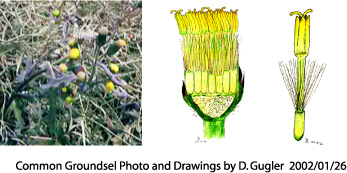

The COMPOSITAE family has 1317 genera and 21000 species. Examples
from the family include asters, goldenrods, thistles, sunflowers,hawkweeds,
ragweeds, burdocks, beggar-ticks, and others in addition to groundsel.
The genus Senecio has 1500 species in the world. There are 11
species of Senecio in Ontario but only 3 in the Hamilton area.
Senecio aureus = Golden Ragwort - a common native plant
Senecio jacobaea = Stinking Willie or Tansy Ragwort - rare, introduced
Senecio vulgaris = Common Groundsel or Old-Man-in-the-Spring - common,
introduced from Europe
According to Allen J. Coombes' Dictionary of Plant Names, Senecio
[see NEE kee oh] comes from a Latin word meaning "an old man, referring to the
fluffy, white seed heads." Vulgaris [vul GAH ris] means "common."
According to France Royer and Richard Dickinson in Weeds of Canada,
common groundsel was brought over from Europe by the Pilgrims in 1620 as a
"treatment for the early stages of cholera."
They further state that each plant is capable of producing over 1 700 seeds
and, due to the fact that it can flower in temperatures below zero degrees Celsius,
it can produce four generations of plants each season. In theory, one seed could
produce over one billion seeds in a year's time. That may explain the English
name that comes from an Anglo-Saxon word meaning, "ground swallower."
The main reason for concern, according to Royer & Dickinson, is that
common groundsel contains an "alkaloid that causes irreversible liver damage
in livestock that feed on plants over an extended period of time."
In Owen and Audrey Bishop's New Zealand Wild Flowers Handbook they
write that common groundsel is also very common in New Zealand. There it grows
and flowers all year round. They say the seeds may last for years underground
and then, when exposed to light by soil disturbance, germinate.
Other names for common groundsel from Timothy Coffey's History and
Folklore of North American Wildflowers include birdseed, chickenweed,
fleawort, grinsel, pigflower, squaw-weed, stanchblood, and Simson.